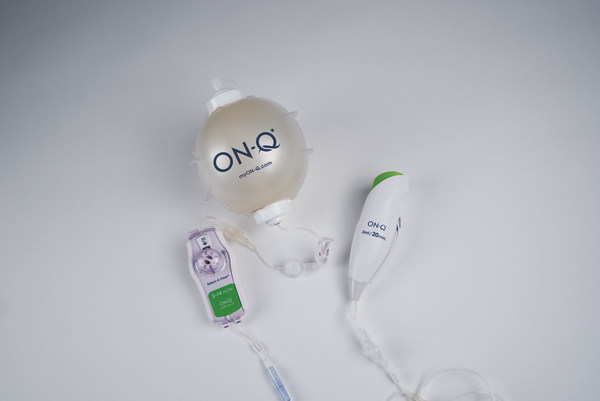ALPHARETTA, Ga., April 3, 2019 /PRNewswire/ -- Avanos Medical, Inc. (NYSE: AVNS), a company focused on delivering clinically superior medical device solutions to improve patients' quality of life, announced today that it has received U.S. Food and Drug Administration (FDA) 501(k) clearance for its ON-Q* with Bolus pump. The new ON-Q* with Bolus design incorporates improvements that make it simpler for providers and patients to use while reducing postoperative opioid use to achieve pain management.

Similar to the original ON-Q* pump bolus device, the new ON-Q* Bolus provides customized control for patients recovering from post-surgical pain by delivering continuous, non-opioid medication to the surgical site or peripheral nerves for up to five days.1,2 The bolus pump is ergonomically designed to fit comfortably in the patient's hand with an easy to remove priming tab and large level indicator markings. As an added benefit to surgeons, the new bolus pump design can be used for incisional applications.
"The changes we have made to the ON-Q* Bolus pump are a direct result of the feedback we heard from our customers," said Joe Woody, Chief Executive Officer at Avanos. "Non-opioid approaches to pain management continue to be an important issue in the healthcare industry, particularly in light of the opioid crisis. As a leader in non-opioid treatment for acute pain, we are committed to continuously improving our ON-Q* pumps to deliver increased quality of life and satisfaction to all patients."
Studies have shown that using bolus rates as low as 3 ml in addition to the basal rate can reduce the total amount of anesthetic needed for pain relief.3 ON-Q* is indicated to significantly reduce opioid use for surgical patients and provide better pain relief than opioids alone, helping patients to get back to normal faster after surgery.2,4-21
The new ON-Q* Bolus pump will be available soon. For more information about the ON-Q* Pain Relief System for the management of acute pain, visit avanospainmanagement.com.
About Avanos Medical, Inc.
Avanos Medical, Inc. (NYSE: AVNS) is a medical technology company focused on delivering clinically superior breakthrough medical device solutions to improve patients' quality of life. Headquartered in Alpharetta, Georgia, Avanos is committed to addressing some of today's most important healthcare needs, such as reducing the use of opioids while helping patients move from surgery to recovery. Avanos develops, manufactures and markets its recognized brands in more than 90 countries. For more information, visit avanos.com.
References
1Abdallah, FW., SH. Halpern, K. Aoyama, and R. Brull. "Will the Real Benefits of Single-Shot Interscalene Block Please Stand Up? A Systematic Review and Meta-Analysis" National Center for Biotechnology Information. U.S. National Library of Medicine, n.d. Web. 03 May 2016.
2 IFU - The ON-Q* Pain Relief System. Instructions for use.
3Ilfeld BM. Continuous Peripheral Nerve Blocks: An Update of the Published Evidence and Comparison with Novel, Alternative Analgesic Modalities. Anesthesia Analgesia 2017; 124: 308-335.
4Auyong DB, Allen CJ, Pahang JA, Clabeaux JJ, MacDonald KM, Hanson NA. Reduced length of hospitalization in primary total knee arthroplasty patients using an updated enhanced recovery after orthopedic surgery (ERAS) pathway. J Arthroplasty. 2015;30(10):1705-1709.
5Beaussier M, El'Ayoubi H, Schiffer E, et al. Continuous preperitoneal infusion of ropivacaine provides effective analgesia and accelerates recovery after colorectal surgery. Anesthesiology. 2007;107(3):461-468.
6Bianconi M, Ferraro L, Traina GC, et al. Pharmacokinetics and efficacy of ropivacaine continuous wound instillation after joint replacement surgery. Br J Anaesth. 2003;91(6):830-835.
7Bingham AE, Fu R, Horn JL, Abrahams MS. Continuous peripheral nerve block compared with single-injection peripheral nerve block: a systematic review and meta-analysis of randomized controlled trials. Reg Anesth Pain Med. 2012;37(6):583-594.
8Dine A. Evidence based outcomes review. Continuing review and evaluation for I-Flow Corporation. July 2012.*
9Forastiere E, Sofra M, Giannarelli D, Fabrizi L, Simone G. Effectiveness of continuous wound infusion of 0.5% ropivacaine by ON-Q pain relief system for postoperative pain management after open nephrectomy. Br J Anaesth. 2008;101(6):841-847.
10Goyal N, McKenzie J, Sharkey PF, Parvizi J, Hozack WJ, Austin MS. The 2012 Chitranjan Ranawat award: intraarticular analgesia after TKA reduces pain: a randomized, double-blinded, placebo-controlled, prospective study. Clin Orthop Relat Res. 2013;471(1):64-75.
11Liu SS, Richman JM, Thirlby RC, Wu CL. Efficacy of continuous wound catheters delivering local anesthetic for postoperative analgesia: a quantitative and qualitative systematic review of randomized controlled trials. J Am Coll Surg. 2006;203(6):914-932.
12Perlas A, Kirkham K, Billing R et al. The impact of analgesic modality on early ambulation following total knee arthroplasty. Reg Anesth Pain Med. 2013;38(4):334-339.
13Webb C, Mariano E. Best multimodal analgesic protocol for total knee arthroplasty. Pain Management. 2015;5(3):185-196.
14White, Jennifer A., "Improving Patient Satisfaction after Primary Total Knee Arthroplasty Using Nurse Practitioner-Driven Preoperative Education" (2015). Doctoral Theses (2015): Paper 13.
15Andersen HL, Gyrn J, Moller L, Christensen B, Dusanka Z. Continuous saphenous nerve block as supplement to single-dose local infiltration analgesia for postoperative pain management after total knee arthroplasty. Reg Anesth Pain Med. 2013;38(2):106-111.
16Capdevila X, Barthelet Y, Ryckwaert Y, Rubenovitch J, d'Athis F. Effects of perioperative analgesic technique on the surgical outcome and duration of rehabilitation after major knee surgery. Anesthesiology. 1999;91(1):8-15.
17Carli F, Clemente A, Asenjo JF, et al. Analgesia and functional outcome after total knee arthroplasty: periarticular infiltration vs continuous femoral nerve block. Br J Anaesth. 2010;105(2):185-195.
18Dowling R, Thielmeier K, Ghaly A, Barber D, Boice T, Dine A. Improved pain control after cardiac surgery: results of a randomized, double-blind, clinical trial. J Thorac Cardiovasc Surg. 2003;126(5):1271-1278.*
19Ilfeld BM, Ball ST, Gearen PF, et al. Ambulatory continuous posterior lumbar plexus nerve blocks after hip arthroplasty: a dual-center, randomized, triple-masked, placebo-controlled trial. Anesthesiology. 2008;109(3):491-501.
20Jaeger P, Nielsen Z, Henningsen MH, Hilsted KL, Mathiesen O, Dahl JB. Adductor canal block versus femoral nerve block and quadriceps strength: a randomized, double-blind, placebo-controlled, crossover study in healthy volunteers. Anesthesiology. 2013;118(2):409-415.
21Mudumbai SC, Kim TE, Howard SK, et al. Continuous adductor canal blocks are superior to continuous femoral nerve blocks in promoting early ambulation after TKA. Clin Orthop Relat Res. 2014;472(5):1377-1383.
SOURCE Avanos Medical, Inc.


